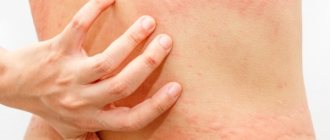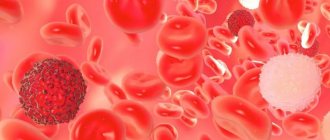What is an allergy?
And so, an allergy is a disorder of the functioning of the immune system, which acquires hypersensitivity in relation to friendly components of the environment. In an organism sensitive to an allergen, in response to its ingestion, immune proteins called “antibodies” are produced. The task of antibodies is to notify the immune system about the invasion of foreign agents. As a result of their signal, the body takes response actions, the purpose of which is to remove the allergen in various ways: through a runny nose or an allergic cough, through the skin and blood vessels. Subsequently, a person exhibits various allergy symptoms (skin, respiratory, gastrointestinal).
Depending on the specific immunity, the consequences of allergies can be caused by two mechanisms of immune reaction:
- Instant response
This mechanism develops as a result of the production of IgE antibodies by plasmacytic cells. Antibodies act on cells that contain histamine (a hormone that starts cascades of inflammatory reactions in allergies). With an immediate response, local immunity of sensitive tissues is involved. As a result, the reaction develops very quickly, since it does not require long-term movements of immune system cells through the general bloodstream to the tissues (this process is called “migration”).
- Long answer
A prolonged immune response is associated with the movement of immune cells directly into the area of sensitive tissues. Basically, it occurs with symptoms of dermatitis. Immune cells, in this case, stimulate the growth of connective tissue, which forms swelling. As a result, specific symptoms appear in the form of a skin rash.
Consequences of allergies
If the patient thinks that an allergy is just some kind of cosmetic defect or discomfort in the form of a runny nose. In fact, allergies are not as simple a disease as they appear upon superficial examination. The consequences of allergies, with bronchial asthma or anaphylactic shock, can be fatal for the patient. For this reason, you should not neglect existing allergic disorders.
The mechanism of development of an allergic reaction
Every day we encounter thousands of substances foreign to the body: viruses, bacteria, pollen, waste products of insects and animals, food, medicines, industrial emissions and many others.
When such a substance enters the body, the process of producing antibodies is launched - special protein compounds that are designed to neutralize the effects of foreign substances. That is, antibodies are a kind of guards inside us. In this case, each antibody is responsible for neutralizing one foreign substance.
If the immune system fails, antibodies are produced in excess. When the allergen enters the body again, they are activated and trigger a cascade of biochemical reactions, as a result of which special substances are produced, including histamine. Its sharp release, in particular, leads to the development of allergy symptoms and their various manifestations.2
Skin effects of allergies
Our skin, due to its protective function, has developed local immunity. Local immunity is a part of the immune system localized within an organ. Unfortunately, in the case of allergies, the immune system works against the person, which leads to various consequences in the form of skin rashes. Skin allergic symptoms can appear either immediately after contact or after a considerable period of time. Sometimes, several weeks may pass from the moment the allergen enters until the skin consequences of the disease develop. A similar variant of the development of the disease can most often be encountered as part of a food or drug allergy.
What can trigger skin allergies:
- Food;
- Components of cosmetics and household chemicals;
- Insect bites;
- High intensity ultraviolet radiation;
- Medications;
- Substances released during industrial production;
- Animal wool;
- Synthetic fabrics;
- Substances contained in plant juices.
Skin effects from contact with an allergen:
- The appearance of various skin rashes. It can be represented by both nodular rashes and acne, as well as redness;
- Development of swelling of skin tissue;
- Expansion of local capillaries;
- The appearance of swelling and redness;
- Intense skin itching. This symptom can indirectly recognize an allergic reaction from other skin diseases;
- Peeling of the skin, appearance of scales;
- Release of fluid. It can be either colorless or have a yellow tint;
- Burning and discomfort in areas where the allergic reaction is localized;
- Violation of the integrity of the skin, leading to the development of bleeding.
Allergic dermatitis
Allergic dermatitis is a group of symptoms that is characterized by a specific type of skin rash that develops after an allergen enters the body. Consequences in the form of dermatitis often occur in people who have allergic sensitivities to foods, medications, cosmetics and cleaning products or materials.
Dermatitis develops more slowly than other types of allergic reactions. The shortest period from contact with the allergen is 4-6 hours, while the maximum can take several weeks. This causes a number of difficulties when determining the substance to which the patient has acute sensitivity.
This consequence of allergy can be identified by the specific mechanism of symptom development. At the beginning, itching and redness of the skin caused by swelling appears. Then peeling develops, which later turns into blistering rashes filled with liquid. From this liquid, if the vesicular formations are opened, a hard, uneven crust is formed. The most common locations for dermatitis are: face, elbows, knees, and groin areas. It is less common on the back, chest and legs. Its distribution is also far from clear-cut. Some people experience mild dermatitis, while others may develop an intense rash that covers large areas of the skin. Dermatitis in children often appears on the buttocks.
Hives
Urticaria is also a common consequence of food, contact or medicinal types. Its symptoms can also be triggered by insect bites, in sensitive individuals, and by components of household chemicals.
The consequences of allergies in the form of urticaria appear very quickly. In some cases, the patient can see firsthand how her symptoms spread throughout the body. This symptom itself represents slightly raised formations of red or pink color. The shape of these formations is rounded, often uneven. They can vary in size, but in general, this symptomatology is quite recognizable.
Neurodermatitis
This consequence of an allergic reaction is a skin manifestation that is directly related to the functioning of the nervous system. In most cases, neurodermatitis is first detected in early childhood and persists for life, returning again after contact with the allergen. A feature of this type of allergy is the intensification of its symptoms during neuropsychic stress.
This disorder can develop as a result of the influence of numerous factors, including: an unfavorable environmental situation, an increasing number of constant allergens (during the development of industry, food production), a lack of vitamin and mineral components, an unhealthy lifestyle, irregular and poor nutrition.
Modern medical science has not come to a certain common denominator in its view of the causes of this disorder. It is not known whether it develops due to nervous or immune disorders. But the influence of the nervous system on symptoms is obvious.
Neurodermatitis can be identified by the following symptoms:
- Strong urge to scratch affected areas;
- Various manifestations of the rash, which can be in the form of blisters, rather large blisters or redness;
- Peeling of the skin;
- Severe edematous-inflammatory processes;
- The appearance of subcutaneous fluid, which tends to extend beyond the skin;
- Increased itching in the evening and before bedtime.
As a result of neurodermatitis, various nervous disorders can develop. During an exacerbation of the disease, a person becomes more nervous, irritable, the ability to concentrate decreases, and night sleep is disturbed.
Signs of food allergies in adults
Food allergies in adults most often develop to:
- Seafood, river and sea fish.
- Eggs.
- Some varieties of fruits and berries, among them the most often allergenic are melons, citrus fruits, strawberries, and red currants.
- Peanuts and some other types of nuts.
- Chocolate and products containing cocoa.
The first signs of intolerance to an allergenic product appear almost immediately after its consumption, and they appear:
- Itching, burning and soreness in the mouth, lips, throat.
- Development of nasal congestion, mucous discharge.
Then, after a few minutes or hours, changes appear in the digestive system, expressed as:
- Pain and colic in the abdomen;
- Nausea, retching and vomiting itself;
- Flatulence;
- Liquefied stool mixed with mucus.
In addition to these symptoms, severe weakness occurs, headache and dizziness are possible. In severe cases, an attack of suffocation develops and anaphylactic shock may occur.
A food allergy in an adult can also lead to changes in the skin - the appearance of rashes, spots, blisters, atopic dermatitis, and itching.
Symptoms of an egg allergy
Egg white is considered one of the most powerful allergens. This type of intolerance in adults is manifested by respiratory symptoms, these are:
- Sneeze;
- Cough;
- Soreness in the mouth;
- Nasal congestion;
- In severe cases, shortness of breath develops.
Skin changes are expressed in the appearance of a rash, areas of hyperemia, and itching. Often, after eating eggs, nausea, vomiting, flatulence, and abdominal cramps occur.
Egg white allergens also negatively affect the state of the central nervous system; under their influence, disorientation in space, dizziness, and a possible drop in blood pressure occur.
Allergy symptoms in adults occur not only to chicken eggs, but also to quail eggs. Although in the latter case the likelihood of intolerance is somewhat lower.
POPULAR WITH READERS: Allergy and psychosomatics, the influence of emotions on the course of the disease
Egg intolerance in adults rarely goes away completely, and in order to minimize contact with this allergen, it is necessary to select products in stores, carefully reading their composition.
Allergy to milk
Symptoms of a cow's milk protein allergy begin to develop within minutes to several hours after consuming this product.
In adults, the development of milk intolerance is explained by a decrease in the body's defenses, chronic diseases of the gastrointestinal tract, which lead to increased permeability of the mucous layer of the stomach and intestines.
An allergy to cow's milk is manifested by the following symptoms:
- Difficulty breathing and shortness of breath;
- Urticaria;
- Colic and abdominal cramps, flatulence, loose stools;
- Signs of acute gastritis;
- Allergic rhinitis and conjunctivitis.
With a true allergy to cow's milk, symptoms appear even if a minimal amount of this drink is drunk.
But people also sometimes have a condition called lactase deficiency, which occurs due to a lack of lactase, an enzyme necessary for the breakdown of milk.
In this condition, signs of allergy in adults increase when consuming large amounts of milk.
Allergy to persimmon
Persimmon is an exotic fruit for us that brings certain benefits. But, like other foods, it can cause allergies.
The specific immune response to persimmon is explained by the tannins, keratinoids, vitamins, fructose and iodine contained in this fruit.
It is this “bouquet” of useful substances that can provoke intolerance to the fruit.
Allergy to persimmon mainly causes the following symptoms:
- Hives. Itchy blisters can form on any part of the body, most often they are located on the forearms, abdomen, and chest. Individual bubbles can merge with each other and thus the person’s condition worsens. Acute urticaria is often accompanied by fever, chills, and general malaise. In severe cases, the rash can spread to the mucous membranes of the throat and oral cavity; this condition leads to swelling and suffocation;
- Sneezing, nasal congestion, swelling of the eyelids, lacrimation. These allergy symptoms in adults occur almost immediately after eating persimmons;
- Cardiac disorders. Persimmon often causes arrhythmia, tachycardia, a drop or, conversely, a jump in blood pressure;
- Swelling of the skin and mucous membranes, which leads to the development of an attack of suffocation;
- Flatulence, loose stools, abdominal cramps.
Less commonly, adults develop allergies to dried or heat-treated persimmons. This is explained by the fact that exposure to high temperatures destroys some of the protein complexes.
Gluten free
Gluten is a plant protein or gluten found in most grains.
An allergy to gluten can occur in both infants and adults; in the latter case, people between 30 and 40 years of age are predominantly susceptible to an unusual reaction of the body.
With gluten intolerance, the body begins to produce toxic substances that disrupt not only the functioning of the gastrointestinal tract, but also the functioning of the kidneys, nervous and endocrine systems, and brain.
Symptoms of gluten allergy in adults:
- Discomfort in the stomach, pain, heaviness, flatulence;
- Atopic dermatitis;
- Stomatitis;
- Nephropathy;
- Joint pain that develops for unknown reasons;
- Headaches, depression.
Allergy to gluten in adults is often disguised as diseases of the gastrointestinal tract with a long-term course.
That is, a person for a long time may be bothered by abdominal pain, colic, severe bloating, diarrhea, alternating with constipation.
Gluten intolerance also leads to a deficiency of the most essential vitamins in the body, and this is manifested by dry skin, dullness and brittle hair, and splitting nails.
Allergy to fish
In most cases, fish allergies begin in childhood. But sometimes, when eating a new fish dish or direct contact with the fish or seafood itself, the disease occurs for the first time in adults.
Pathology develops due to special proteins found not only in the muscle layer of fish flesh, but also in caviar, and even in scales and mucus.
This is why allergy symptoms may appear when processing fresh fish.
The most common manifestations of allergies to fish and fish dishes include:
- Formation of a rash and then blisters on the flexor surface of the arms, on the abdomen, thighs, and face. The appearance of a rash is accompanied by the development of itching;
- Swelling of the eyelids and face;
- Burning sensation on the mucous membranes of the mouth, tongue, and throat. The burning sensation begins to bother you almost immediately after eating even a small piece of fish;
- Nausea, vomiting, diarrhea;
- Headache, fever and chills.
Severe allergic reactions to fish often develop.
Anaphylactic shock can be recognized by such signs as dizziness, darkening of the eyes, severe weakness, pale skin, and fainting.
If such symptoms occur within a few minutes, you should immediately call an ambulance.
For coffee
A true allergy to coffee should be considered a reaction of the body that appears after drinking a drink made from fresh beans.
If the disease appears on coffee from cans, then it is necessary to exclude other “culprits”; these could be flavorings, flavor enhancers and other additives.
A true allergic reaction to coffee in adults appears for the first time in connection with past diseases of the liver, intestines, or after infectious processes.
Symptoms of coffee allergy in adults:
- Sneeze. It usually appears as a harbinger of all manifestations and occurs when inhaling the smell of coffee and when preparing the drink. Subsequently, sneezing is accompanied by nasal congestion and mucus discharge;
- Deterioration in breathing, shortness of breath, and an attack of suffocation in most cases develop if too much drink is drunk at one time;
- Pinpoint rash, blisters on different parts of the body. Peeling, areas of redness, and itching in most people with a coffee allergy appear near the mouth, on the cheeks, and near the ears.
- Some of the symptoms of intolerance to certain chemical components of coffee include headache, palpitations, and fever.
An allergy to coffee is also indicated by the fact that you develop drowsiness instead of vigor after drinking a freshly prepared drink.
Allergy to chocolate
Chocolate is a multi-component food product, and what exactly causes an allergy when consumed can only be determined through special skin tests or prick tests.
Symptoms of chocolate allergy in adults:
- Pinpoint rash and urticaria. Red spots and peeling can also form on the skin of the face and spread to the mucous membranes of the oral cavity;
- Respiratory disorders - sneezing, the appearance of a large amount of mucus, signs of suffocation;
- Swelling of the skin and mucous membranes;
- Indigestion in the form of nausea, diarrhea;
- Asthmatic attacks.
In adults, the severity of symptoms of chocolate intolerance depends on the amount of the product eaten.
Whereas in children, all signs of an allergy appear even if a small piece of a chocolate bar is eaten.
This page describes chocolate allergies in more detail.
Allergy to protein
Almost any food product contains proteins, they are divided into animal and vegetable.
- Animal proteins include protein from meat, fish, and cow's milk.
- Vegetables include protein found in cereals, cocoa beans, and nuts.
Symptoms of an allergic reaction to protein are manifested by food intolerance, among which respiratory manifestations, gastrointestinal disorders and skin changes come first.
If you are allergic to protein, you must remember that some types of animal proteins are included in serums and vaccines, which means that these medications are prohibited for use.
Allergy to sweets
The term sweet allergy refers to an intolerance not to sugar, but to the components contained in sweet pastries, candies and other products.
Symptoms of the disease are associated with poor digestion of foods containing sucrose.
As a result, toxic substances are formed that are perceived by the immune system as foreign proteins.
The main manifestations of an allergic reaction after eating sweets are:
- A rash on the skin, most often its localization is the stomach, cheeks, buttocks. The formation of rashes is accompanied by itching;
- Inflammation of the mucous membranes, swelling of the lips and tongue. Swelling can lead to an attack of suffocation;
- Stomatitis;
- Allergic rhinitis;
- Migraine;
- Quincke's edema;
- Anaphylactic shock.
POPULAR WITH READERS: Are allergies caused by nerves? Let's figure it out
Intolerance to sweets in adults mainly occurs against the background of chronic diseases of the digestive system, and therefore disorders of the stomach, liver, and pancreas can be observed.
Allergy to citrus fruits
Citrus fruits are the fruits that contain the most allergens. In adults, an allergy to this fruit often develops when it is overdosed.
The main symptoms are conjunctivitis, manifested by lacrimation and redness of the sclera, and rhinitis, accompanied by sneezing, runny nose, and the formation of large amounts of mucus.
If an allergy develops against the background of an exacerbation of chronic diseases of the digestive system, then a skin rash appears almost immediately.
The locations of the rashes do not have clear zones and are very itchy. In severe cases, citrus fruits can lead to anaphylactic shock.
Consequences of allergies for the respiratory (breathing) system
The respiratory consequences of allergies represent the lion's share of the symptoms of this disease. They arise as a result of the ingestion of allergens, along with the inhaled air. This determines the nature of the substances that provoke respiratory symptoms. They must be so light that their weight ensures the ability to move through the air. The most common allergens are: plant pollen, dust, poplar fluff, volatile components of cosmetics and household hygiene products, animal hair.
The difficulty for a person who is sensitive to respiratory allergens is their prevalence. Take plant pollen, for example, the most common cause of respiratory allergies. It spreads over many kilometers from the original source, penetrating into homes, entrances, and public places. May settle on furniture and other household items. As a result, during flowering, an allergic person has contact with it around the clock, to varying degrees of intensity.
Manifestations of respiratory allergies:
- Severe attacks of sneezing, which the patient begins to experience immediately after exposure to the allergen;
- Swelling and dilation of blood vessels in the nasal mucosa;
- Difficulty breathing;
- Migraines due to lack of oxygen;
- Swelling of the areas adjacent to the nasal passages;
- General weakness and malaise;
- A sore throat, reminiscent of a cold;
- Attacks of dry cough;
- Sinus irritation;
- Inflammatory processes of the vocal cords, which in some cases cause temporary loss of voice;
- Watery eyes, redness.
Respiratory allergies develop almost instantly after contact with allergens. Its symptoms do not arise on their own, but are gradually eliminated without interaction with the provoking substance.
How to protect yourself from the consequences of respiratory allergies:
- Frequently wash linen, especially curtains, curtains and drapes;
- Clean the room using a wet method. Pay close attention to the cleanliness of windows and window sills;
- Try not to store soft toys and decorative pillows at home, as these items accumulate large quantities of material and other dangerous components;
- Remember that smoke, perfumes, deodorants, air fresheners, dust, dry air increase the symptoms of respiratory allergies;
- Use various devices to purify the air circulating in the room;
- Do not allow low air humidity in the room in which you are often located;
- If you are allergic to animal hair, you should study in detail what materials are included in the products you use.
- After contact with the allergen, rinse your nasal passages using a saline solution of warm water (1 teaspoon per half liter of water), take a shower with soap, wash your hair and put your clothes in the wash.
Causes
The cause of allergies in adults can be the characteristics of the body and many other factors.
The most common causes of the disease:
- Plant pollen . The manifestation of characteristic signs of allergies occurs during the period when trees and plants begin to bloom - this is usually spring and summer. Small particles of blooms are a powerful aeroallergen that moves into living spaces.
- Poor nutrition . Harm to the body is caused by food additives, products with the addition of GMOs, as well as semi-finished products, soda, fast food, most sweets, food with no or minimal content of vitamins and microelements. Often people have a reaction to seemingly completely harmless foods: honey, soy, wheat, chocolate, nuts, milk, seafood and fruits.
- Household chemicals . All chemicals intended for home care contain active substances that are strong allergens and can cause serious harm to human health. Before using such products, it is very important to first familiarize yourself with the operating instructions.
- Medications . Often the cause of an allergic reaction is certain medications, in particular antibiotics, which belong to the penicillin group.
- Impact of external factors . Sometimes this disease can occur inside the body. These factors can provoke diseases such as arthritis, hypothyroidism and rheumatism. Sun and cold also cause negative effects.
- Dust, dust mites . House dust contains plant pollen, fabric fibers, skin flakes of dust mites, etc. Street or book dust can cause no less harm to the body.
- Insects, spiders, snakes, etc. Many insects, spiders and other fauna are carriers of poison, which, when bitten, quickly enters the body and can cause a fairly strong allergic reaction. If immediate action is not taken, the situation could be fatal.
Other causes of an allergic reaction in the body include:
- hereditary predisposition;
- psychological, emotional stress;
- mold, fungal spores;
- foreign proteins that enter the human body through donation or as a result of the introduction of a vaccine;
- dysbiosis in the intestines;
- cosmetical tools;
- synthetic clothing;
- animal hair and saliva;
- duvets, pillows;
- entry of parasites into the human body.
Bronchial asthma as a consequence of allergies
The presence of respiratory allergies, in some cases, can trigger the development of bronchial asthma, the symptoms of which develop after contact with allergens. In this regard, we are talking about allergic bronchial asthma.
By what mechanism does bronchial asthma develop?
The allergen stimulates the release of biologically active substances that cause certain transformations in the organs of the respiratory system; Exposure to these substances stimulates contraction of the muscles that surround the bronchi; Mucus secretion develops inside the bronchial canals, which makes breathing even more difficult; As a result of the reduction of the bronchial lumen, attacks of suffocation occur.
Attacks of bronchial asthma cause a sharp closure of the airways, as a result of which the patient breathes frequently and with great difficulty. The breathing process, in this case, is carried out by the skeletal muscles of the chest. During asthma attacks, the patient experiences a severe and severe cough, which resolves with the appearance of sputum removed from the inflamed bronchi.
To treat bronchial asthma, not only antiallergic drugs are used, but also special anti-asthmatic drugs. Attacks of bronchial asthma are stopped directly with the help of special inhalers containing substances that relieve bronchospasm.
Signs of allergies on the face
Allergies in adults on the face are manifested by various rashes, blisters, and local swelling.
In women, swelling often appears when using low-quality cosmetics, and in this case it can form on the eyelids, under the eyes, and on the lips.
The intolerance reaction is often expressed by individual hyperemic spots, severe dry skin, and the appearance of scales and cracks.
All allergic signs on the face can be accompanied by itching, which further increases irritation of the skin.
The face of an adult also shows signs of a condition such as Quincke's edema. This is expressed by severe swelling of the eyes and lips, itching and the transition of swelling to the mucous membranes of the mouth, which leads to an attack of suffocation.
Dangerous consequences of allergies
Anaphylactic shock
This type of allergic manifestation is perhaps the most dangerous consequence of this disease. Similar symptoms develop in people who have a characteristic feature of the immune system, expressed in the presence of acute sensitivity to any allergen.
So, what is anaphylactic shock and what dangerous consequences can it cause? And so, most often this symptom develops with an allergy to insect bites (especially bees, wasps, bumblebees and hornets); medicinal substances; food products (nuts, chocolate, honey, shrimp, milk, eggs - most often). As a result of allergenic exposure, spasm of the larynx and bronchi develops, as well as swelling of the mucous membranes of this area, blood pressure decreases critically, and the patient feels a lack of oxygen due to blockage of the respiratory tract. As a result of anaphylactic shock, cardiac arrest may develop.
Consequences and complications
In addition to the symptoms that significantly worsen our lives, allergies have many dangerous consequences. For example, eczema, bronchial asthma, and atopic skin diseases often develop against its background. In addition, allergies are a background for the development of other pathologies that can affect almost all organs and systems.
Against the background of allergies, other somatic and infectious diseases are more severe. In addition, they are more difficult to diagnose, since their manifestations often overlap with those of allergies, and, as a result, it is quite difficult for doctors to prescribe drug therapy without causing an allergic reaction to it.
And, of course, you need to remember the high risk of anaphylactic shock, which is directly life-threatening. Moreover, it is almost impossible to predict against the background of exposure to which allergen it will develop.1, 2
Consequences of taking antiallergic drugs
Allergy symptoms are managed with the help of various medications that are used to relieve them. For this reason, a discussion of the consequences of allergies would not be complete without indicating the consequences caused by the side effects of medications.
| a drug | consequences |
| antihistamines |
|
| corticosteroid drugs |
|
| eye drops |
|
| nasal drops |
|
| allergy ointments |
|
Diagnostics
To determine the allergen that is the source of the disease, it is worth contacting your doctor, since only an accurate diagnosis contributes to a positive prognosis for treatment.
The following methods are used for diagnosis:
- Skin tests. The patient is introduced to various allergens, then their effect on the body is analyzed.
- Blood test for IgE. Allows you to identify the content of IgE antibodies, as well as their interaction with certain allergens.
- Provocative tests. The patient, under the supervision of doctors, is injected with suspected allergens that cause an allergic reaction in the patient.
- Application and skin tests. A mixture of Vaseline or paraffin and a mixture of various allergens is applied to the patient's skin. This composition remains on the patient’s body for two days, after which laboratory tests are carried out to identify the pathogen that caused the allergic reaction. If there is no reaction, the doctor re-prescribes this test.
Consequences of allergies for children
In the first years of life, the child’s body is in a state of extreme vulnerability and can react by developing allergic reactions to a wide variety of substances. This is determined by the characteristics of the baby’s developing immunity. Over time, many children who suffer from allergic reactions in childhood say goodbye to them as they grow older. Most allergic reactions in children develop as a result of improper feeding, as well as in cases where the mother does not adhere to a special diet. As a result, allergic reactions develop as a result of allergens entering the mother's milk.
Food allergies in children can have consequences on the digestive system, which are manifested by bloating, stomach pain, stool disorders and other gastrointestinal disorders. As a result of irritation of the walls of the stomach and intestines by allergens, the baby’s food is poorly absorbed. Subsequently, the child experiences a nutritional deficiency, which negatively affects the growth and development of the child’s body.
Allergic reactions can also be a consequence of lack of breastfeeding. Through mother's milk, the child's body gets used to food components, as a result of which the child's immunity works correctly. Also, breast milk is an extremely important component of a healthy diet for a baby. At the moment there is simply no worthy alternative to it. This must be taken into account when organizing breastfeeding, which modern women practice less and less. Moreover, these cases are not always associated with objective contraindications.
The conditions in which the child lives must be clean, but excessive sterility leaves the baby’s immunity unemployed. Therefore, do not abuse in this matter, but stick to reasonable measures. After all, many parents, with the best intentions, protect their child from the slightest speck of dust. As a result, we get immunity that simply does not know how to work correctly.
Causes of allergies in adults
The main cause of any allergic reactions in adults and children is considered to be a specific immune reaction to a foreign protein that has entered the body. Moreover, this irritant can act both from the inside and from the outside.
Frequent allergens are food, medications, household chemicals and cosmetics, household dust and plants.
The development of allergies for the first time in an adult is explained by a number of specific provoking factors, these primarily include:
- Living in unfavorable environmental conditions. It is noted that most often allergies occur in residents of those cities where the air is polluted by the work of various factories and factories.
- Chronic diseases of the digestive system. Liver diseases, pancreatitis, gastritis lead to the development of dysbiosis in a person, and this interferes with the absorption of nutrients and increases the body's sludge load. Against the background of these changes, the immune system also begins to malfunction.
- Infestation with parasites. The vital activity of helminths leads to the formation of a large number of toxins, and this does not allow the immune system to work at full strength.
Heredity, bad habits, and the use of products containing various antibiotics, hormones, and dietary supplements play a certain role in the development of allergies.
Often, allergies in adults appear for the first time after long-term treatment with antibiotics.
Folk remedies
When treating pathology, proven folk remedies are often used.
- Allergy talker . To prepare the product, you need to mix ethyl alcohol with distilled water. Add here white clay, zinc oxide, anesthesin cube (if not, baby powder). For better effect, you can add a little diphenhydramine. Shake the mixture until smooth and apply to the skin.
- Series . It is recommended to treat skin allergies with a decoction of the string or add it to baths. This decoction can also be taken internally.
- Black cumin oil . This oil is an effective remedy against various forms of the disease, including seasonal ones. It activates the body's immune functions. Black cumin oil is taken as inhalation.
- Chamomile . Chamomile is an excellent remedy for various forms of dermatosis. To prepare it, you need to pour boiling water over the herb and wait 15–20 minutes until the leaves absorb the water. Chamomile leaves should be cooled and applied to inflamed skin.
- Nettle . As a preventative measure, it is recommended to add regular nettle to your menu, for example, to cabbage soup. This plant strengthens the human immune system.
- Kalina . It is a general tonic. To prepare the composition, you need to make an infusion of viburnum shoots (only young ones) and take it orally several times a day.
- Soda . To treat allergic reactions, regular baking soda is used. For oral administration, mix 0.5 teaspoon of soda in a glass of boiled water and take on an empty stomach, 30–40 minutes before meals. For external use, it is recommended to use a soda solution, which helps cope with allergic skin reactions.
- Collection . This collection is often used for medicinal purposes at any stage of allergy. To prepare it, you need to mix the fruits of St. John's wort, rose hips, centaury grass, corn silk, horsetail and dandelion root. Mix everything thoroughly, add the mixture to a thermos and pour boiling water over it. The product is infused for at least 7 hours, after which it is cooled and filtered. Take orally for several months.
Prevention
Prevention of the disease includes simple recommendations:
- eat healthy food enriched with essential vitamins and microelements;
- wear clothes made from natural fabrics;
- if necessary, refuse down pillows and blankets;
- adhere to the rules of personal hygiene;
- do not come into contact with household chemicals without protective gloves;
- do not use low-quality cosmetics;
- follow the recommendations of a diet specialist;
- stop drinking alcohol;
- avoid stress;
- do wet cleaning in residential premises at least twice a week;
- Avoid working in places with poor ventilation; otherwise, be sure to use protective masks;
- do not forget to clean the dust filters of devices such as a vacuum cleaner, air purifier and air conditioner;
- If you are prone to allergic reactions, it is recommended to carry antihistamines and an allergy passport with you.
Allergy prevention includes simple ways to prevent initial manifestations and prevent relapses. If you are susceptible to this disease, it is recommended to follow all the recommendations of a specialist to prevent the development of the disease.










